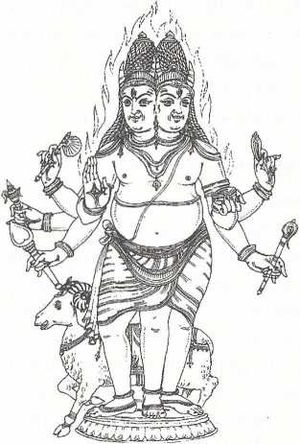Agni
By Swami Harshananda
Agni literally means
- Fire; lightning; the sun;
- Fire as one of the five traditional physical elements that make up the world of matter
- The prominent and central fire-deity of the Vedic pantheon, who is hailed as the mediator between the Gods and humans, and the receiver of oblations and sacrifices of behalf of the Gods, who symbolizes the flame of Divine Will or Force of the Divine Consciousness working in the cosmic creation and manifestation; the sovereign guardian of the south-east quarter, the twin brother of Indra, the husband of Sudarśanā and Svāhā, and father of Dakşiņam, Gārhapatyam and Āhavanīyam[1]; the preceptor of the gods, protector of ceremonies, of men, the summit of the sky, the centre of the earth and the conferer of immortality[2]; one of the eight Vasus[3]; the south-east direction.
According to the scriptures, every elemental force is presided over by a deity. The presiding deity of tejas, fire and heat, is Agni. The Vedas place Agni, the deity of fire, get a key place in Vedic hymns. A large number of them are devoted to describing and praising Him. Some of his attributes are described as follows:
- He is the Supreme God, the creator, the sustainer and the all-pervading cosmic spirit.
- All the other deities are His different manifestations. He manifests himself as fire (agni) on this earth, as lightning and air (Indra and Vāyu) in the sky and as the sun (Surya) in the heavens.
- He acts as a mediator between men and Devas by carrying the sacrificial offerings of men to Gods.
- He is very powerful and merciful too.
- Though an immortal, he lives among the mortals, in every house. He protects them by dispelling their difficulties and fulfills their wishes. Without him, the world can never sustain itself.
In the epics and the purāṇas, He is said to have been born out of the face of the Virāṭ Puruṣa (Cosmic Being). He is married to Svāhā, the daughter of Dakṣa. He consumed the Khāṇḍava forest with the help of Arjuna whom he rewarded with divine weapons e.g., the Gāṇḍīva bow. He helped Indra be relieved of a part of his sin of brahmahatyā (killing a brāhmaṇa) and restored Sītā to Rāma after she had entered the fire to prove.
Agni is represented as an old man with a red body. He has two heads, a big belly and six eyes, seven arms in which he holds objects like the spoon, ladle, fan etc., seven tongues, four horns and three legs. He has braided hair, wears red garments as also the yajñopa- vīta (sacred thread). He is attended on either side by his two consorts, Svāhā and Svadhā. The smoke is his banner and the ram is his mount.
As sacrificial fire, Agni has five aspects known as Pañcāgni:
- Gārhapatya
- Āhavaniya
- Dakṣiṇā or anvāhāryapacana
- Sabhya
- Āvasathya
References[edit]
- The Concise Encyclopedia of Hinduism, Swami Harshananda, Ram Krishna Math, Bangalore
- Agni by Jit Majumdar

